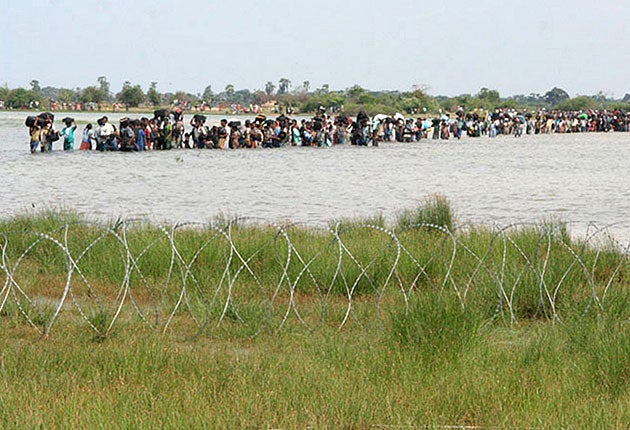35,000 civilians flee as army moves on Tamils
Sri Lankan military gives Tamil Tigers and their leader 24 hours to surrender or face crushing attack

Your support helps us to tell the story
From reproductive rights to climate change to Big Tech, The Independent is on the ground when the story is developing. Whether it's investigating the financials of Elon Musk's pro-Trump PAC or producing our latest documentary, 'The A Word', which shines a light on the American women fighting for reproductive rights, we know how important it is to parse out the facts from the messaging.
At such a critical moment in US history, we need reporters on the ground. Your donation allows us to keep sending journalists to speak to both sides of the story.
The Independent is trusted by Americans across the entire political spectrum. And unlike many other quality news outlets, we choose not to lock Americans out of our reporting and analysis with paywalls. We believe quality journalism should be available to everyone, paid for by those who can afford it.
Your support makes all the difference.It began with ones and twos, small groups of people rushing to escape. Then the groups got larger. Very quickly the thin line of people had become a flood.
That was the scene as thousands of civilians trapped inside Sri Lanka's war zone dramatically escaped yesterday morning, just hours after the country's Defence Minister said he had given the "green light" for a rescue operation. Precisely how many escaped was impossible to verify as journalists and most aid groups are prevented from reaching the area, but President Mahinda Rajapaksa said he believed up to 35,000 people had crossed into government-controlled territory, describing the exodus as the "largest-ever hostage rescue mission in history".
As the government revealed remarkable images taken by pilotless drones flying over the so-called "no-fire zone" that it said showed thousands of people fleeing, the authorities also announced a 24-hour ultimatum for the rebels and their leader, Velupillai Prabhakaran, to surrender or face crushing military action. "We have given Prabhakaran 24 hours to get out of town. The next step will be to remove [the rebels]," said a defence ministry spokesman.
Yesterday's exodus came after a firefight between government forces and the fighters of the Liberation Tigers of Tamil Eelam (LTTE). The greenish images showed crowds of people running westwards towards the front line. Some crossed a lagoon while others could be seen scrambling down an earth embankment that had been breached by the troops. "People were wading through the water, chest deep," said Vice Air Marshal Kolitha Gunatilleke.
Mr Gunatilleke, who showed images of the escape during a press briefing at the air force control centre in Colombo, estimated the civilians had to run just one mile to reach government-controlled territory, where large crowds of people could be seen massing around a makeshift processing centre.
The military said 17 fleeing civilians were killed and 200 wounded by three LTTE suicide bombers. Meanwhile, the pro-rebel TamilNet website said several hundred civilians were believed to have been killed or injured after troops advanced into the zone at about 5am. Before yesterday's operation, the United Nations had said it believed up to 150,000 civilians, of which about 50,000 were children, were trapped in the war zone, measuring just seven square miles. Aid groups say the LTTE has stopped people from leaving and there have been repeated calls both for the rebels to free the civilians and for the government to enact a ceasefire. The UN estimates that 4,500 civilians have lost their lives in the conflict in the past four months.
There is particular concern about the thousands of children trapped in the area. Government medical officials there, whose claims are denied by Colombo, say there are inadequate supplies of food and that many mothers are too malnourished to feed their babies. "The living conditions are dire," said James Elder, a spokesman for Unicef in Sri Lanka. "Children are lacking essentials such as water, food and medicines." The images released by the military showed a large number of civilians living directly on the beach, hiding in bunkers and sheltering under pieces of blue tarpaulin. The military said it believed many LTTE fighters were living among civilians there, making it impossible to effect a rescue using boats.
The government said the exodus had forced it to step up its humanitarian preparations. A senior official claimed the authorities had been ready to deal with about 100,000 civilians, but the actual figure may be 30,000 higher.
All the civilians are being taken to refugee camps encircled by razor wire. Sri Lankan officials say they will be held there for up to a year while de-mining operations are carried out and they are assessed as potential security threats. Conditions are very basic and refugees have complained of a lack of water.
While many say they are happy to be out of the war zone, almost all are concerned about how long they will have to stay before they can go home.
Join our commenting forum
Join thought-provoking conversations, follow other Independent readers and see their replies
Comments